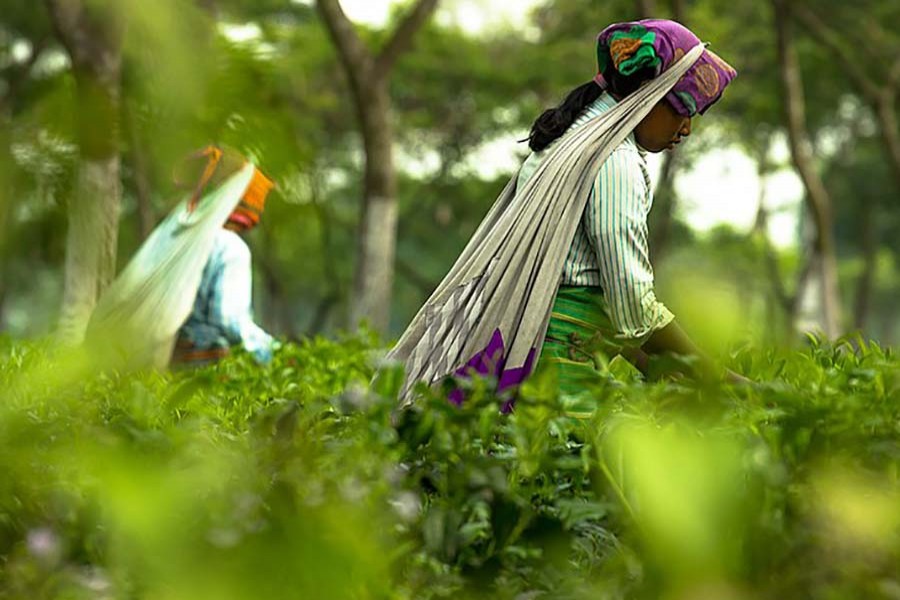As the tea sector is thriving fast, the ‘made-tea’ output marked 57 per cent increase last year than previous year in the ‘Kartoa Valley’ ecological zone comprising of five sub-Himalayan northern districts.
Officials at Panchagarh regional office of Bangladesh Tea Board (BTB) said 8.467-million kilograms ‘made-tea’ was produced in 2018 which is higher by 57 per cent than the output of 5.440-million kilograms ‘made tea’ in 2017 in the valley.
“Tea was cultivated on 7,645 acres of lands in Panchagarh, Thakurgaon, Dinajpur, Nilphamari and Lalmonirhat districts last year in the valley,” said Senior Scientific Officer of BTB at Panchagarh Dr Mohammad Shameem Al Mamun.
Of them, tea was cultivated on 2,243 acres of land in nine registered and 19 unregistered tea gardens and on 5,402 acres of land in 4,450 small-scale gardens in these five districts last year.
In Panchagarh, 7.822-million kilograms of ‘made tea’ was processed from 37.7-million kilograms of green tea leaves produced on 6,792 acres of land last year.
In Thakurgaon, 0.645-million kilograms ‘made tea’ was processed from 3.907-million kilograms green tea leaves produced on 742 acres of land last year.
Besides, 115 small growers cultivated tea on 111 acres of land in Dinajpur, Nilphamari and Lalmonirhat districts last year.
‘Tea farming is expanding fast as BTB is implementing ‘Expansion of Small Holding Tea Cultivation in Northern Bangladesh Project’ since 2015 at Tk 49.7 million to expand tea farming by more 500 hectares of land within 2020 in the valley,” Mamun added.
The `small-scale gardening-basis’ tea cultivation on plain lands has become a highly profitable venture inspiring the local farmers to expand its cultivation.
“Following continuous expansion of tea cultivation, production of green tea leaves is boosting every year in the valley bringing fortune to many farmers and creating jobs for the poor, especially women,” Mamun added.
“Thirteen tea companies are processing tea after producing green tea leaves in their gardens as well as purchasing the same from farmers to produce ‘made-tea’ in Panchagarh and Thakurgaon for selling at Chittagong Auction Market,” Mamun said.
Earlier, 3.2-million kilograms ‘made-tea’ was produced in 2016, and 2.521-million kilograms ‘made-tea’ in 2015 and 1.421-million kilograms ‘made-tea’ in 2014 and 1.455- million kilograms ‘made-tea’ in 2013 against only 0.161- million kilograms in 2005 when commercial basis cultivation began in Panchagarh, reports BSS.
Talking to reporters, influential tea grower Matiar Rahman of village Sonapatila in Panchagarh said he began cultivating tea on his 0.45 acres of land as a small-scale tea grower for the first time in 2002.
“I am cultivating tea on about 52 acres of land now as a small-holder and selling the produced green tea leaves to 13 tea processing companies,” Rahman said.
Similarly, small-scale tea farmers Abdul Hakim, Solaiman Ali, Abdur Rahman and Sekendar Ali of different villages said that tea farming has brought fortune to their families enhanced their standard of living.
Predicting brighter prospect for expanding tea farming in the ‘Kartoa Valley’ ecological zone, President of Panchagarh Chamber of Commerce and Industry Abdul Hannan Sheikh said the tea sector is thriving economy is getting a boost in the northern region.


